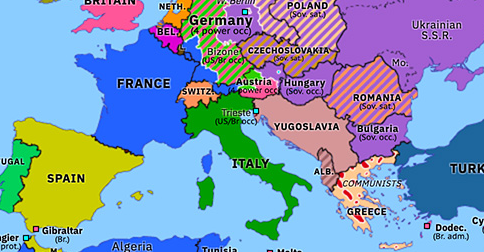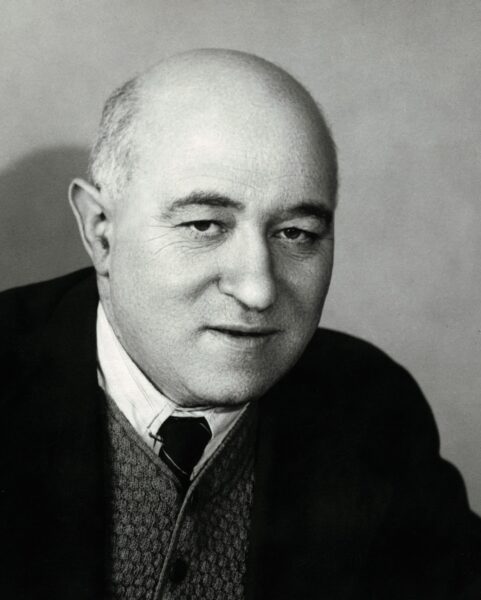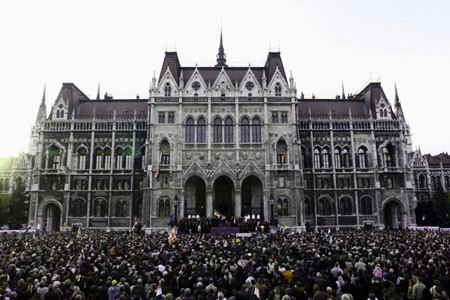Maybe not better red than…
The Second World War had ended. Hungary had signed the 1947 Treaty of Paris returning it to its pre-1938 borders. Unlike Yugoslavia where Tito’s Partisans had ruled the day, the Soviet Army playedô a major role in “liberating” Hungary.ô Thus, before transferring authority fromô its occupying forces to the Hungarians, the Soviets made certain they had installed a government that, largely for appearances and as a sop to the westô included some moderates, but that was, in fact, dominated by communists.ô Thus, Hungary began to fall within the Soviet sphere of influence.

[Map from Omniatlas.]
Even in the immediate post-war period, the Hungarians chafed not only against the Soviets but, suspicious by nature and generationally conservative, the populace also distrusted the home-grown communists as well. In fact, in November 1945 the Western Allies, who perhaps saw Hungary as a possible check against growing Soviet influence, pressured the Soviets to authorize what was essentially the only free election to take place in post-war eastern Europe. Imagine the Russians’ irritation then when a center-right party called the Independent Smallholders’ Party (ISP) won 57 percent of the vote while the Hungarian Communist Party garnered a mere 17 percent. The election’s freedom ended there. Despite the ISP winning an outright majority, the Soviet commander in Hungary refused to allow the Smallholders’ Party to form a government. Instead, they were forced to form a coalition government with the Communist Party, the Social Democrats, and the left-wing National Peasant Party although the ISP was given the office of Prime Minister.
By early 1947, the ûllamvûˋdelmi Hatû°sûÀgô (AVH) orô State Protection Authorityô which wasô headed by a staunch communist began arresting leaders of the ISP and charging them with “conspiracy against the republic.” Hungary held a second round of post-war elections in August 1947. Even with many ISP leaders imprisoned, andô despite being aided by widespread election fraud, the Communist Party increased their share of the vote to onlyô 24 percent.
Unable to win at the polls, the Soviet influenced communists changed tactics and eventually forcefully organized all the so-called democratic parties into a single entity called the People’s Front headed by long time communist loyalist MûÀtyûÀs RûÀkosi seen below.

[Photo from Wikipedia – Public Domain.]
Parliament passed a new constitution in August 1949 that was modeled after the 1936 constitution of the Soviet Union and the nation officially became the People’s Republic of Hungary.
23 October 1956.
Sometimes a single eventô or a single date willô resonate so stronglyô within a bonded group of people – whether that bond is ethnic, religious, or nationalist – thatô it leaves an imprint that transcends history and generations. ô For Hungarians, what happened beginningô on 23 October 1956ô represents just such an event.
Little good happened in Hungary in the immediate post-war period. Led by Stalinist disciple MûÀtyûÀs RûÀkosi, Hungaryãs Communist Party very much followed the Stalinist Soviet model. Aggressive nationalization of industry and education, unrealistic five-year plans, and repressive purges by the AVH burdened Hungarian society. An economic yoke that saw per capita national income rise while standards of living fell contributed to a rising tide of unrest. Like their counterparts in the Soviet Union, Hungariansô facedô chronic shortages of basic food staples requiring rationing ofô bread, sugar, flour, and meat.
Following Stalin’s death much of eastern Europe experienced a brief period of moderate liberalization. Hungarians elected the reformist Imre Nagy as Prime Minister. Behind the scenes however, RûÀkosi, who retained his position as General Secretary of the Communist Party, worked to thwart some of Nagy’s relatively modestô attempts at reforming Hungary’s economic and political system.
In the early part of 1955 Nagy, followingô notions being espoused in Austria,ô considered adopting a declaration of neutrality but by April 1955, RûÀkosi, who would himself be deposed fromô his position a bit more than aô year later, managed to discredit Nagy and haveô him removed from office. On 14 May of that year, in response to the integration of the Federal Republic of Germany (West Germany)ô into NATO,ô the Soviet Union established the Warsaw Pact that encased the Soviet Union and seven satellite states including Hungary in a similar military mutual defense alliance.
A violent uprising by workers in Poznaé, Polandô in June 1956 eventually led to a series of concessions by the Soviets known as Polish October. These concessions, together with RûÀkosi’s resignation in July, emboldened Hungarian reformers. University students around the country began snubbing the official communist student union in favor of the newly re-established and more democratic Union of Hungarian University and Academy Students. When they learned that the Hungarian Writers’ Union was planning a pro-reformist march for 23 October, they rapidlyô organized their own demonstration as a show of unity.
The demonstrations started out quite peacefullyô on Buda’s side of theô Danubeô before the students crossed theô river to join other demonstratorsô on Kossuth Square in front of the Parliament Building.
By 18:00, the crowd was reported to be more than 200,000 people. Within hours, the new Secretary General of the Communist Party, Erné Geré, broadcast a speech not merely rejecting, but condemning the demands of the writers and students. The demonstrators reacted by carrying out one of their non-policy demands – the removal of Stalin’s statue on the square – pulling it from its perch. By 21:30, they’d succeeded in toppling the 9-meter statue.
Meanwhile, a few blocks away, another demonstration was occurring in front of the Radio Budapest building. It was here that the peaceful demonstrations turned violent. A group of protesters tried to enter the building so they could air their demands and it was at this point that members of the AVH began lobbing tear gas and shooting into the crowd from the building’s upper floors.
Later that night, Geré officially requested Soviet intervention and the Russian tanks began rolling into the city by 02:00 on 24 October.ô In an attempt to appease the demonstrators, in the afternoon of the 24th, Imre Nagy was returned to office replacing AndrûÀs Hegedû¥s as Prime Minister.ô Nagy promised toô enact some of theô political reforms that RûÀkosi had thwarted during his first stint in the office three years earlier. Theseô included free elections and withdrawing Hungary from the Warsaw Pact.
The calendar turned to 25 October. With protesters still gathering in large numbers outside the Parliament building, all hell broke loose. Although Soviet tanks were positioned around Kossuth Square and at most bridge crossings, they hadn’t yet engaged the demonstrators. At this point, members of the AVH, who had taken positions in some of the surrounding buildings,ô began firing on the crowd. Thinking they were being shot at, the Soviets began shooting back. Armed protesters in the crowd also began shooting and the situation deteriorated into chaos.
If you’re really interested, you can watch this 20-minute BBC documentary:
